



The stated aim of FutureSonic 2009 was to consider how the city disconnects us from “nature and the consequences of our actions”. As Drew Hemment puts it in the curatorial statement, “the tarmac of the road cuts us off from the earth beneath and the festival set out to find the ‘cracks in the pavement’ and look for ways to reconnect with nature through the use of new media technologies and participatory processes.”
With its theme of Environment 2.0, FutureSonic proposed that we revise our notions of the world we inhabit. Described as the place we all “share, connect with and create”, Environment 2.0 attempts to bring together the enterprise culture of the ‘social Web’ with an ecological understanding of environment (in which interdependent entities and conditions co-evolve).
So how does the festival’s espousal of web2.0 mantras of empowered togetherness fit with an ecological approach? The new tools of networked sociability can mask functional inversions of the communitarian impulse to which they appeal. In contrast with Free and Open Source Softwares (often social softwares) published under the GNU GPL[1] whose workings are transparent, web2.0 social softwares (such as Twitter, Flickr and Facebook) are ‘free’ to use because their creators have found (or soon expect to find) a discreet way to harvest the hidden value of some aspect of the unwitting users’ behaviour. Value is built by users’ interactions and activities and when successful, the utility, its users’ content, habits and personal data are put to work on the financial markets in the service of industrial “bottom line” principles. So what? This looks like a winning formula doesn’t it? We get useful, free stuff, and technical innovators get rewarded.
A recent interview with new media theorist Douglas Rushkoff describes how we have internalised corporate values and then replicated and deployed them in the modelling systems of computers and the Internet. We are just simply corporate ourselves and we made it in our image again.[2] He sets out in simple terms the toxic consequences of the process. A consumer society has been created to perpetuate economic growth. It is based in speculation through colonial activities rather than the creation of ‘real’ more local value. It seeks short term satisfaction over long term work leading ultimately to the destruction of developing nations, our environment and to our own bankruptcy.
What follows is a reflection on these themes with reference to some ideas and works presented at the FutureSonic festival. This account focuses especially on artists’ and technologists’ explorations, of participation and agency in a networked society in the context of environmental crisis. It also reflects on some of the effects of a partial application of an ecological approach in this celebration of the new techno-green-enterprise soon to become FutureEverything.
In 1971 Guy Debord observed how ‘pollution’ had become a fashionable concern in exactly the same way as had ‘revolution’. In his conference presentation at FutureSonic 2009 Tapio Makela, co-founder of M.A.R.I.N. (Media Art Research Interdisciplinary Network), questioned the growth of events addressing arts, ecology and science, observing that ‘revolution’ doesn’t seem to be so much in fashion today but pollution still is, though it is now called climate change; this year is already crowded with arts festivals addressing environmental questions.
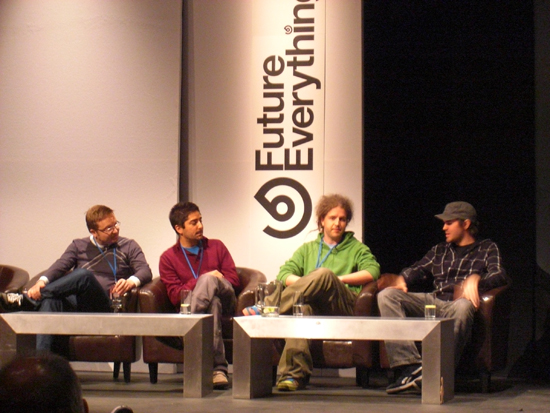
Tapio Makela’s conference presentation addressed a key question, ‘How can we make the environment more tangible and open for interaction?’ As he explained, ‘from a Western humanities tradition, environment seems to resist constructivist positions for the self that would enable agency for action’. He argued that environmental data is usually presented with an authoritative (and therefore detached) ‘view from above’ and described a need for a radical aesthetic for information design. He proposed this question as one ideally suited for exploration by media artists. And we agree. Media artists’ experimental processes, tools and media, frameworks and potential agility in relation to viewers/participants create ways in which complex information could be better processed, felt and differently experienced.
Usman Haque counts amongst those practitioners who start to address this question. His ‘radical aesthetic’ arises from his positioning within the network; from seeing himself as part of everything and asking himself the political question ‘what can I do?’ In his conference presentation he disentangled environment from the romantic concept (another detaching notion) of untouched nature, saying
environment is that which is generated through our existence. It’s the thing that we actually create. An environment is as much part of us as it is part of our existence.
His view of environment as being about relations is explored in two projects featured in the exhibition. Pachube, is an online platform to share and use sensor data. It explores the effect of actions or a set of conditions as they overlap with another; streaming real time data gathered by sensors (measuring for instance humidity, light, temperature, or energy consumption) located around the world. This data can then be used to control conditions in remote environments.
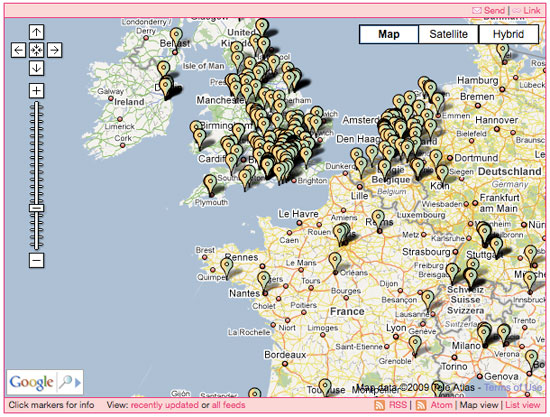
Possible uses include having your Second Life environment respond to sensors in the real world; connecting up basic home-automation devices so that they respond to other distant environments; connecting up your electricity meter to track it over time and embed usage graphs in your own website, or calculate your real-time carbon footprint.
The second work presented by Haque, Natural Fuse, consists of a circuit in which the elements are a fuse, a plant and a power socket. The amount of electricity available to the appliance through the socket is only that which can be offset by the plant’s carbon-sequester capabilities. The fuse has got two functions, fuse care and fuse kill. Fuse care works when there is still energy left to use, activating a water-controlling system. Fuse kill is activated when too much energy has been used and it literally kills the plant, breaks the circuit and it allows no electricity flow through the outlet.
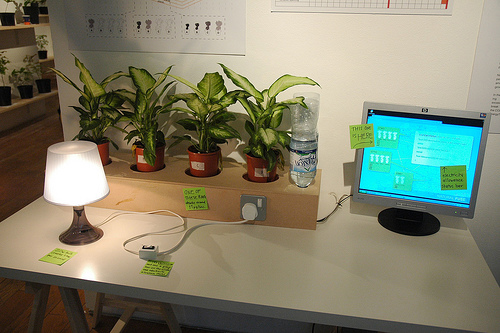
Haque proposes that Natural Fuse should work together with Pachube as a way to illustrate an alternative set of invisible relations and their effects in a networked environment. Using this system in an exhibition installation redolent of school project, a 50w light bulb was shown to need 402 average sized yucca plants to offset the carbon generated when it is switched on. In his conference presentation Haque used this to highlight the flaws in the offsetting approach to carbon-emission reduction, pointing out that at our current levels of energy consumption we would need entire uni-personal forests in order to reach anything like the necessary reduction in carbon emissions. As Cambridge University botanist Oliver Rackham puts it
planting trees to mitigate climate change is like drinking more water to keep down rising sea levels.
This engaging demonstration-system questions how we might become aware of these effects in order to relate differently to each other and to our environment. It draws the viewer into a calculation process that impacts on their perception of their energy consumption in relation to the complex questions about what right-action might follow.
David Griffiths‘s presentation of groWorld, a video game that explores ideas of guerrilla gardening and permaculture, suggests another way to engage peoples’ ability to both feel and know. Griffiths is developing the game together with FoAM – an organisation based in Amsterdam which works at the intersection between ecology, culture and technology. For him artists contribute by increasing public engagement and encouraging scientists to think in radically different ways.
Avatars in groWorld will not only be controlled by people but also by plants, using sensor data (for humidity, Ph level, temperature, etc.) drawn from ‘real’ gardens to shape game behaviours. Griffiths pointed out that many urbanites have lost the capacity to grow their own plants and vegetables, unable to produce either their own food or gardens. In groWorld, a community of real and virtual gardeners exchange techniques and ideas with the purpose of recovering important knowledge on the topic. This game claims to achieve a higher level of hybridity between virtual and actual worlds than traditional video games, in that it is controlled by bio-data in a way that produces horticultural knowledge in the players.

The works and ideas discussed so far engaged us, through processes of calculation and learning, with the some of the scientific and material realities of climate change. Urban Prospecting by Jon Cohrs, exhibited in the exhibition at Cube, makes us ‘feel’ the debate quite differently. A set of modified metal detectors equipped with hydrocarbon sensors for tracking oil ‘resources’ were displayed, in the style of a trade fair, along with a ‘promotional’ video.
Drawing on gold rush hopes and imagery, urban prospectors appear in the video to endorse the product’s ability to deliver great riches to their owners. “It’s as easy as walking the dog!”. Sumps of spilt oil and toxic waste are to be found in former industrial areas ripe for commercial exploitation through resale to the black market or litigation against the polluting corporations.
This joyful satire of opportunism and greed provides one of the few critiques presented at FutureSonic that account for the role of complex economic and ideological interests, in debate and action, surrounding climate change. The values (or at least the spirit) of America’s self-made-man, mining for black gold, sits uncomfortably comfortably alongside those of the hardware hackers and media activist dudes. “Being green has never been this cool”.
Cohrs’ exploration of ethical compromise, within the networks of market and media, contrasts sharply with Flight Patterns by artist, designer and researcher Aaron Koblin. This data visualisation project shows the traces of all the planes crossing the United States in one day. The result is a stunning animation, the beauty of which suspends the critical faculties and with them, any associations with toxic carbon emissions and the warming effects of contrails. Rather, the data driven imagery evokes clean travel through boundless, clean skies that could well be sponsored by one of the large airlines and exhibited on a huge screen in an airport terminal to sooth fretful passengers. How could anything that looks so natural be problematic?
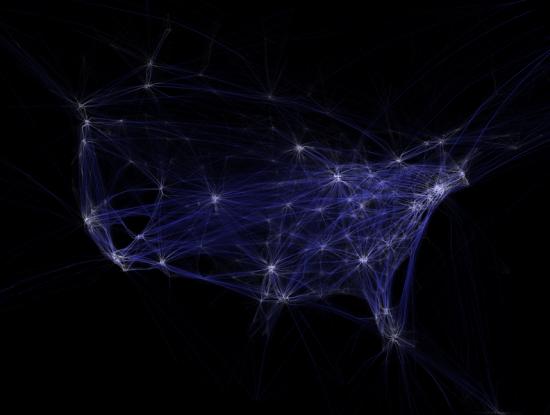
In the discussion that followed Koblin’s conference presentation, he acknowledged that when processing huge amounts of data for an artwork the artist is forced to present a particular point of view in order to make it accessible and comprehensible to the public. In that sense data-visualisation projects will always have a political implication and therefore carry a certain responsibility. One can see this principle in action in an excellent earlier Internet artwork by Koblin, The Sheep Market, “a series of 10,000 simple images of sheep drawn by online workers. Stylistically the sheep range from the indecipherable to the extremely detailed and cute […] They serve as a metaphor for the sharecropping masses of Web 2.0 projects. And their production speaks of the future of art and creative production.”[4] Viewers of and participants in The Sheep Market are addressed specifically as Internet users, allowing them to contribute a drawing or buy stickers and so drawing them into the economic and political relations that are the subject of the work. This is a wonderful example of the potential range of the media artists’ rich palette. Unfortunately Flight Patterns, though beautiful, fails to position, or connect with, the viewer who maintains a dreamy, apolitical distance from the subject of the work.
HeHe presented video documentation of Nuage Vert (Green Cloud), a data visualisation project with direct and purposeful public engagement. A site-specific laser projection on a cloud of vapour emissions, produced by a power plant in Helsinki, takes the shape of the cloud by measuring heat with thermal video analysis while the size varies depending on the levels of energy consumption.
HeHe organised the Unplug event in Helsinki which citizens were asked to switch off all appliances and go out to look at the green cloud. The cloud was supposed to grow as consumption fell. Consumption fell by 800 kVA – which is equivalent of the power generated by one windmill running for one hour. The accomplishment of this project is the way it connects directly to energy consumption and pollution at the very site where it occurs and in doing so achieves the kind of radical data visualisation to which Tapio Makela aspires; connecting sets of information, re-presenting their effects to the very people who have a part in their generation.
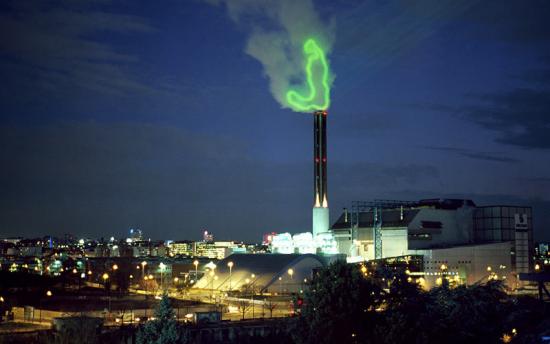
Less successful was Climate Bubbles, one of the three, large scale, participatory projects devised by FutureSonic in collaboration with Natural History Museum and Lancaster University. Biotagging: Manchester and One Hundred Years of Climate Change were the other two.
Climate Bubbles by Drew Hemment, Alfie Dennen and Carlo Buontempo set out to map local heat flows within the city. To do so, people were invited to blow soap bubbles, to track and document the paths they took and to upload the results to the website – a fun activity that would contribute to the body of scientific knowledge. At the time of writing, the map on the project’s web page does not show any of the measurements contributed by participants. It is therefore hard to imagine how participants were able to gain any sense of their contribution to the social or scientific aims of the project or to get a sense of their role either in relation to the location, or to the others who took part. As one of the most highly visible keynote projects in the art bit of FutureSonic this particular work testifies to the shadow side of the festival by taking a technocratic approach to participants. It proposes a distracting and flawed framework for collective agency in Environment2.0 and its positioning in an art context only adds to the confusion.
On the surface Amy Balkin‘s three day performance Reading the IPCC Fourth Assessment Report could be interpreted as an attempt to raise public awareness about the causes, effects and mitigation of man-made climate change by making its findings accessible (or at least the existence of the report known) to festival visitors. The collective reading did serve this purpose to a small degree, however it was as a multivalent artwork, rather than as a public information service, that it had a more profound impact. Festival visitors signed up online to participate by giving a 20-minute reading of a section of the report from a simple lectern, in the foyer of the Cube gallery or outside on the pavement. They could also sit and listen on one of the 6 chairs provided and be served a cup of Feral Trade coffee or tea.
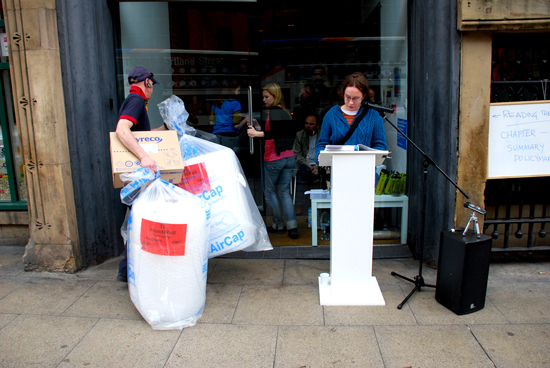
The artwork took as its materials the relationship between the IPCC report and participants in the performance (or more specifically their position in relation to issues of climate change). The report’s impressive use of jargon from the political and bureaucratic disciplines (as well as those of social and material science), combined with its length produced a range of experiences and knowledge in its readers and listeners. The participants and text came alive in unpredictable ways as the audience spontaneously interrupted and interacted with the reader to comment on particular points, to offer their own perspective, to cry out with frustration at particularly dense and obscure sections or to break off into tangential conversations. These revealed visitors’ self-reflexive awareness of the part they played in an allegory. Their participation in the performance of an impossible task (the text was just too long and dense to stand any hope of being read in full) resonated with their evident anxieties in relation to collective task (of climate change mitigation) under discussion. Through this sparely crafted framework for participation the artwork interrogated a set of questions around individual agency and public engagement with questions of environmental crisis. It also demonstrated the potential sophistication of sentient public participation in art action.
Most of us find ourselves in daily contradiction with our principles and this should not prevent us from holding and exploring our principles. Our intentions are also often mismatched with the effects of our actions. This is the human condition. However, an ecological approach must incorporate feedback processes for evaluating and making adjustments in response to the effects of these contradictions and mismatches. In his influential anthology, Steps to an Ecology of Mind[5], Gregory Bateson clearly sets out the dangers of attempting to instrumentalise living beings, no matter how apparently worthy the goal. The loss of flexibility that arises in an evolving civilisation when it ignores complex (bottom up) feedback in blinkered pursuit of a single process can be fatal for an ecosystem. Research by social scientists such as Tim Jackson on sustainable consumption also demonstrate the fatal consequences of persistent political attachment to economic growth and extravagant consumption as the sole ideological monorail to the future.[6]
So it was sinister to note how narrowly the frame of debate had been set at this year’s FutureSonic. None of the conference presentations we attended acknowledged the role of corporate and institutional power in Environment2.0. The role of economic interests or perverse effects of ‘free’ markets remained undiscussed. Instead most lines of thought were singly directed to technical solutions for environmental crisis, characterised by uncritical optimism and blind trust in technological progress as the ultimate counter-force to anthropogenic climate change. Jamais Cascio, an affiliate at the Institute for the Future and a fellow at the Institute for Ethics and Emerging Technologies provided a distillation of the general tone of the Social Technologies Summit:
I think we are going to make it through the century and I think what we’ll come out with at the end of the century will be wondrous.
So it appears that while participants are encouraged to run about blowing bubbles, connecting and shaping the physical and virtual Environment2.0 someone, somewhere else is running the economic and political bottom-lines.
The organisers of FutureSonic deserve recognition for a diverse line up of emerging and high-profile practitioners and some well wrought copy that appeared to attract a high turn out. It also gathered some important work and ideas together. First, projects like Pachube highlighted the value of sharing information about our environments as a crucial step towards acting upon it responsibly. Second, the festival highlighted an emerging field of experimental practices that deal with the growing hybridity of networked virtual and physical realities.
We think we understand FutureSonic 2009’s drive to conflate the coordination of mass social behaviours, demonstrated by web 2.0 ‘utilities’, with the sharing and critical practices of participatory media arts. If the precise and transforming effects of an encounter with the best of the dialogic media arts were to be distributed at scale they could perhaps make some significant contribution to the quality of connection and co evolution of humans and Environment2.0. They might also provide an alternative approach to sustaining radical artistic practice with diverse and interdisciplinary partners and collaborators.
However (and we know that it’s difficult), the ambitious aims of the programme were seriously undermined by a lack of focus in the conference line up and a casual approach to exhibition curation. Many of the works in the exhibition were poorly presented and contextualised (artistically and technologically). And then it was just plain unclear what lots of the works and projects were doing there, or what they contributed to the debate. This was very frustrating and felt like a waste of an opportunity. At a time when the value of media arts is being eroded by the dominant (scale and numbers-obsessed) agendas of creative industry and threatened with cuts in public funding by an impoverished national treasury[7] we cannot afford to present an incoherent interface. It just contributes to the already ill-informed arguments out there for the dismantlement of our arts culture. It’s even more crucial in the context of environmental crisis that we don’t settle for generalisations and approximations and that we attempt to be clear about where optimism is possible and where we have to allow uncertainty. As Bateson points out there are some times when appearing to do the job is just not good enough.
Choosing environment as a framework for a media arts festival carries with it a certain responsibility. To work at this scale, to make sense of work at the intersection of artistic and technological culture, to gather the resources and partners to produce a critical and conscious cross-section of what is really happening out there, and to take the necessary time to make sure that things are communicated well is a huge undertaking. We therefore applaud the ambition and energy of the FutureSonic team.
Perhaps though, as with environmental issues in general, a radical aesthetic of organisation and engagement is required. One that allows closer attention to local concerns and participation. One that incorporates an authentic engagement with connected, complex ecologies; felt, experienced and constructed at both local and translocal levels and visible from all points both above and below.
Footnotes
1. Corporate Dominance of Every Aspects of Our Lives Is Suffocating us, Douglas Rushkoff interviewed by Helaine Olen, AlterNet. August 7, 2009. http://www.alternet.org/media/141828/are_we_all_corporate_shills
2. For more about the GNU General Public License http://www.gnu.org/copyleft/gpl.html
3. Corporate Dominance of Every Aspects of Our Lives Is Suffocating us, Douglas Rushkoff interviewed by Helaine Olen, AlterNet. August 7, 2009. http://www.alternet.org/media/141828/are_we_all_corporate_shills/#comments
4. Rhea Myers. http://www.furtherfield.org/displayreview.php?review_id=244
5. Bateson, Gregory. Steps to an Ecology of Mind, in Collected Essays in Anthropology, Psychiatry, Evolution, and Epistemology, Chicago Press: 1972.
6. ‘Why Politicians Dare Not Limit Economic Growth’ by Tim Jackson, 15th October 2008 for New Scientist http://tinyurl.com/6784zw
7. See REAL-TIME POLITICAL ART OUT OF THE DIGITAL UNDERGROUND by Armin Medosch 2007 for an analysis of various economic and cultural cul-de-sacs for media arts http://www.ambienttv.net/footprints/book/02medosch.html#7